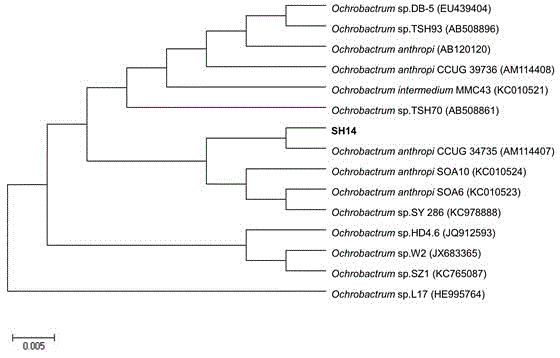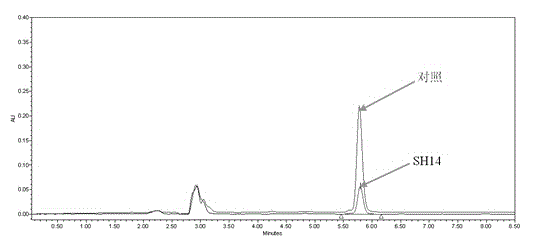Azoxystrobin degrading bacterium and microbial inoculum produced by using degrading bacterium and applications of degrading bacterium
A technology of azoxystrobin and bacterial strains, which is applied in the field of environmental microorganisms and agriculture, and can solve problems such as bioremediation of pesticide residue pollution that cannot be satisfied
- Summary
- Abstract
- Description
- Claims
- Application Information
AI Technical Summary
Problems solved by technology
Method used
Image
Examples
Embodiment 1
[0031] Example 1 Isolation and identification of Pallidum pallidus SH14
[0032] The inventors isolated and screened the azoxystrobin-degrading bacteria by enrichment culture method. Environmental samples for enrichment of azoxystrobin were collected from activated sludge from sewage treatment ponds in Singapore. Take 5 g of the activated sludge sample and add 50 mL of basal medium (the formula is: (NH 4 ) 2 SO 4 , 2 g; MgSO4, 0.2 g; CaCl 2 , 0.01 g; FeSO 4 , 0.005 g; MnCl 2 , 0.002 g; K 2 HPO 4 , 10.5 g; KH 2 PO 4 , 4.5 g in 1000 mL distilled water, pH 7.5). At the same time, the mother solution of azoxystrobin original drug (DMSO as solvent) was added to make the final mass concentration of azoxystrobin 50 mg / L, and the degrading microorganisms were enriched and cultured at 30 °C and 150 r / min on a shaking table. After culturing for 7 days, transfer them to the second batch of basal medium containing 100 mg / L azoxystrobin at a 10% inoculum size. After culturing u...
Embodiment 2
[0038] Example 2 Preparation of Pallidum pallidus SH14 liquid preparation
[0039] The production process of using the above-mentioned Pallidum pallidum SH14 to prepare the liquid preparation is as follows: slant seed—shake flask seed liquid—seed tank cultivation—production tank fermentation—package as liquid bacterial preparation.
[0040] The strains of Paleobacterium pallidum SH14 were activated on LB solid plate, and inoculated on the inclined surface of the test tube for later use. Inoculate the test tube species of Pallidum pallidum SH14 into 1000 mL shake flask containing 250 mL of LB medium, the formula of which is: yeast extract 0.5%, peptone 1%, NaCl 1%, pH value 7.5. 30 ° C is shaken at a constant temperature to the logarithmic phase, and the seed tank is prepared to be inoculated, and the liquid volume of the seed tank is 70%. At 1.1 Kg / cm2 after feeding 3 Under the pressure of 121 ° C, high-pressure damp heat sterilization under the condition of 121 ° C, af...
Embodiment 3
[0042] Example 3 The biodegradation effect of azoxystrobin by Bacillus paleus SH14
[0043] Azoxystrobin was added to the basal medium (same as Example 1) to make the final concentration 50 mg / L; the inoculum concentration was 1.0×10 7 CFU / mL bacterial agent, and set the culture medium without inoculation as the control, culture at 30 °C for 0-5 days, take samples regularly, use HPLC method to measure the residual amount of pesticides and calculate the degradation rate, the results are shown in Table 1 and image 3 shown. The results showed that P.pallidum SH14 could effectively degrade azoxystrobin in a short period of time, and the degradation rate of azoxystrobin reached 76.8% within 3 days, and 86.3% within 5 days. degradation effect.
[0044]
PUM
 Login to View More
Login to View More Abstract
Description
Claims
Application Information
 Login to View More
Login to View More - R&D
- Intellectual Property
- Life Sciences
- Materials
- Tech Scout
- Unparalleled Data Quality
- Higher Quality Content
- 60% Fewer Hallucinations
Browse by: Latest US Patents, China's latest patents, Technical Efficacy Thesaurus, Application Domain, Technology Topic, Popular Technical Reports.
© 2025 PatSnap. All rights reserved.Legal|Privacy policy|Modern Slavery Act Transparency Statement|Sitemap|About US| Contact US: help@patsnap.com



